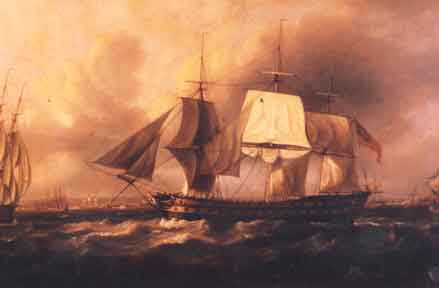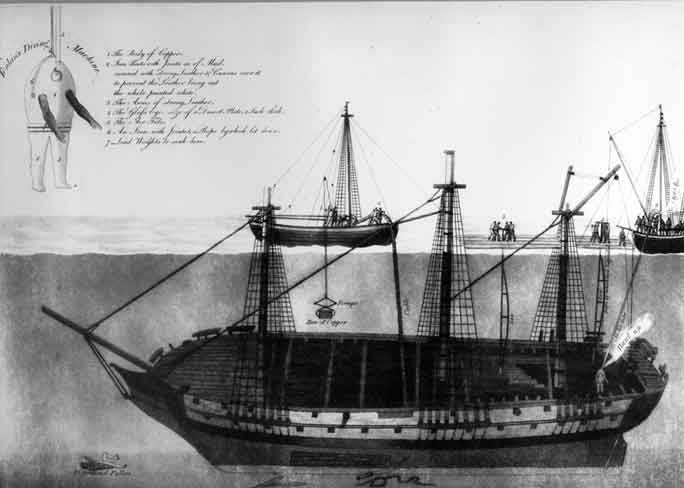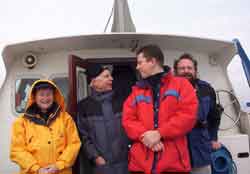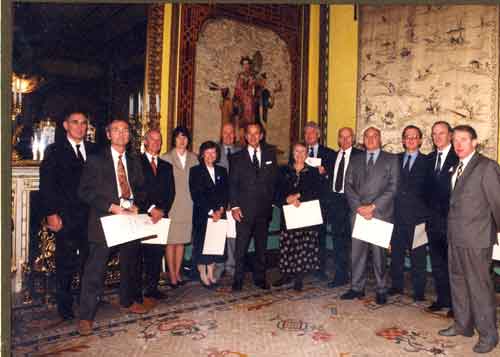|
The
Wreck of The Earl of the Abergavenny,1805
|

The East Indiaman, the Earl of
Abergavenny |
I have
had the privilege of diving
with Ed Cumming and his Weymouth Underwater Archaeological Group on the
wreck of the East Indiamen, the Earl of Abergavenny during the
1990's. The ship sank on February 4th 1805. 'Over 250
souls perished from drowning or exposure on that bitterly cold
February night in 1805. They included her commander, John
Wordsworth, a loss which Wordsworth scholars suggest contributed
to the passing of Williamís highest imaginative powers.' To
quote Ed's website the ship lay:
One and a half miles off the Dorset coast
at Weymouth, 20 metres below the surface, lies the wreck of the
Earl of Abergavenny. Built by Thomas Pitcher at
his yard in Northfleet, Kent in 1797 she was one of the largest
class of merchant ships chartered to the Honourable East India
Company. The remains of this 1440 ton vessel, cargo and personal
possessions lie scattered over the seabed, washed by the ebb and
flow of the gentle tides in Weymouth Bay. Her proposed eighteen
month long voyage, first to Bengal and then to China, would have
taken the Abergavenny to the very frontiers of the
known world, through hostile seas where disease, piracy and
uncharted hazards exacted a heavy toll on those courageous
merchantmen.
Success would have made the
Abergavennyís commander John Wordsworth a fortune, money
he intended to share with his brother William in order that he
could pursue his poetic genius. Barely had the voyage started
however, when confusion, poor weather and an incompetent pilot,
allowed the Abergavenny to strike the notorious
Shambles bank just south of Portland Bill, Dorset, England.
Although the Abergavenny finally managed to clear
the bank and attempt to sail for the sands of Weymouth Bay, the
hull was too badly damaged and she sank in sight of land.
|

Salvage efforts in 1805 |
To dive on the wreck we would set off for
the day from Weymouth Harbour on the Black Tigress captained by
its skipper, the unforgettable Dave, a member of the local
Weymouth lifeboat crew. We dived singly, in strict
rotation down to the anchor chain to about 20 metres and then
along the dredge hose, when the visibility was poor, to the site
of the hull. The days before computers we kept religiously
to a six hour gap between dives. There, during the recognised
dive time we dredged the silt away to expose a knee or a plank,
hopefully to find some artefact of value, Small crabs
scuttled round us and fish swam across the wreck. At the
back of the dredge small artefacts would drop in the outgoing
stream and this included many flints which were being exported
for the rifles, muskets and revolvers of the Indian army.
We would fill our goodies bags with the, small chards of china,
bases of glass ware, ingots of copper, soles of shoes, bones and
other sad relics which we scooped up during our excavation work. Lifting
gear was necessary to heave up the lead ingots, used as ballast
on the ship
I was lucky enough to a small seal in ebony and gold with
'Cosmas' on one side and 'lisez and taisez -vous' on the other.
It belonged to a young midshipman by the name of Cosmas or his
father. Dragging these artefacts up to the surface
ascending up the anchor rope the other divers would look eagerly
at our 'finds'. Occasional we would find an interesting one of
historic value. Ed has recorded the finds meticulously on
his website.

Some of the team members
Ed
Cumming was the winner of the British Sub Aqua Club Duke of
Edinburgh Gold Award in1996 for his enterprise and a number of
his fellow divers joined him when he received it at Buckingham
Palace in the Chinese Room, the room that lead on to the
famous balcony. Each of us received a certificate to commemorate
the award.

The
Chinese room in Buckingham Place where the award to Ed Cumming
took place in 1996. I am in the centre next to the Duke of
Edinburgh. Ed is second from the left holding his gold
award.
On February 4th 2005
200 years after the Earl of Abergavenny had sunk off Weymouth
harbour with the loss of 274 lives a number of the diving group
commemorated the occasion with the unveiling of a plaque at the
entrance to the harbour on the quayside. A wreath was
taken out to sea in the Weymouth lifeboat and Ed Cummings threw
it on to the waters where the ship had sunk. Prayers were
said for the souls of the departed.
|

The East Indiaman flag made
by Barbara Cumming,
The memorial, the wreath and those
present at the commemoration prior to tossing the wreath
into the sea where the wreck lay for 200 years. |
Ed Cumming's site
www.weymouthdiving.co.uk/wrecks.htm
http://www.weymouthdiving.co.uk/research.htm
The Loss of the Earl of Abergavenny
Photos taken from the video camera of
the Earl of Abergavenny Excavations,
|